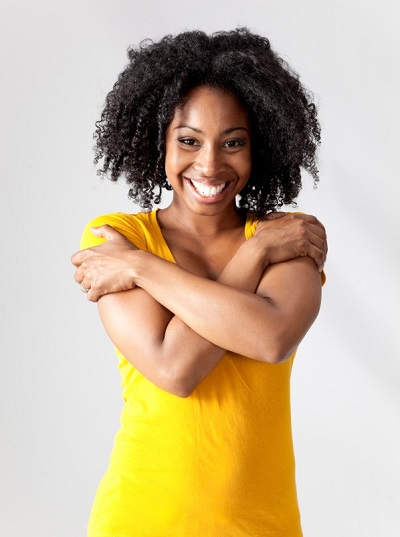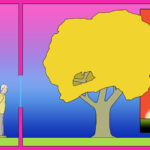Self-kindness is an open-armed embrace of who one is and what one has done and not done.
That’s a definition I find helpful. Note what is not part of the definition:
- Judgment of who one is.
- Judgment of what one should have done or not done.
The opposite of self-kindness is self-judgment.

It’s human to wish some things were not true. We may wish some things about ourselves were not true. We may wish we had done some things or not done others. We may wish profoundly that what’s happening were not true.
We naturally try to turn away from what we don’t want to be true. Unfortunately, when we cut ourselves off from any part of what is true, we cut ourselves off from the wholeness of what is real. But it’s the wholeness of reality that is our resource. Turning towards reality is like playing a gardening video game. Instead of having to earn and buy shovels one-by-one, you open the door to a shed full of shovels, rakes, and trowels, all within reach!
You might be thinking:
“Yes, but I don’t want what’s true to be true! I don’t want to need tools! It’s all so scary and sad and frustrating!”
Exactly. This is all true.
Self-kindness is grounded in the concept of “opposites can both be true.”
Here are two examples that might make sense right now:
“I wish things were different AND I will need to figure out how to handle things as they are.”
“I feel scared and sad and frustrated AND I will need to figure out how to feel these feelings and still handle what’s happening.”
To practice self-kindness, one modifies the wording of one’s thoughts.
Let’s do an example.
Please become aware of what feelings you have as you read this sentence. To keep things simple, try one of the “big four” feelings words: “mad,” “sad,” “glad,” “afraid.”
“I am really struggling with what’s happening. I should be a stronger person. I should be handling this better.”
Many people feel mad at themselves when they judge themselves as not being and doing what they believe to be “correct.” They try to scold themselves into doing better. Scolding hurts. People naturally back away from what hurts.
Please become aware of what feelings you have when you read this sentence:
“I embrace who I am and what I have done and not done AND I am really struggling with what’s going on right now.”
When they approach the reality of what they’re feeling and thinking about how things are, many people feel sad and scared. These feelings hurt in a different way. We’re tempted to back away.
Self-kindness often involves acknowledging the reality that one feels sad and scared. Many people try to avoid these feelings. But they are there. This is why the image in this post is a person giving herself a hug. When people feel sad and scared, they need comforting.
Self-kindness starts with a self-hug.
Self-kindness creates a bit of calm and stability, even in the hardest times. When eased a bit within, people can begin to take a look at their own inner resources and at the external resources available to them – the tools in their tool sheds. Then they can begin to think of ways to use what they have on hand to be helpful to themselves.
“Yes, but,” you may be thinking. “I have done terrible things. I said I would do some things and didn’t do them. I don’t deserve self-kindness.”
The first of these statements may be true. But opposites can both be true. Looky:
“I recognize I have done some things, didn’t do some other things, and have caused harm to others. I deeply regret these things AND I see that change can start with self-kindness. I might want to make some changes. Even though I might not understand exactly how this would work, self-kindness might be a place for me to start.”
Self-kindness takes practice.
Please take a moment to compose an “opposites are both true” statement of self-kindness like one of the examples I’ve given.
Self-Kindness Group members read these aloud to each other, filling our virtual Zoom room with warm kindness.
. . . . .
The Self-Kindness Group for Virginia residents meets on Thursdays from 5:30 – 6:45 PM EDT. Here’s more about this CBT-based, online counseling group. This post consists of the notes I used for the skills instruction portion of our inaugural meeting on Thursday, 3/26/20. In our 75-minute groups, skills instruction takes about 15 minutes, then group members take turns sharing, processing, and problem-solving.
Although I wish the group could be open to all, registration and Virginia residency are required to be a member of the Self-Kindness Group.
The next session on Thursday, April 2, 2020 at 5:30 PM EDT, will include a guest appearance by Wren West, L.P.C., a licensed professional counselor in Roanoke, Virginia. Sometimes “opposites can both be true” results in conflict between our feelings vs. our thoughts! We plan to hold an extemporaneous dialogue between feelings (Wren) and thoughts (Anne) to show how acknowledging the reality of both feelings and thoughts results in a remarkable synergy of inner wisdom to guide us.
If you’d like to look ahead, these are the handouts we’ll be using for context:
The concept of “opposites are both true” is a component of dialectical behavior therapy, a form of cognitive behavior therapy. If you would like to read an in-depth discussion of this concept, this article might be useful.
If you would like to join the Self-Kindness Group, other groups, or request other counseling services, please learn more about appointments and fees, then use our contact form to send me your email address. I will email you registration information through our client portal.
The views expressed are mine alone and do not necessarily reflect the positions of my colleagues, clients, family members, or friends. This content is for informational purposes only and is not a substitute for medical or professional advice. Consult a qualified health care professional for personalized medical and professional advice.

